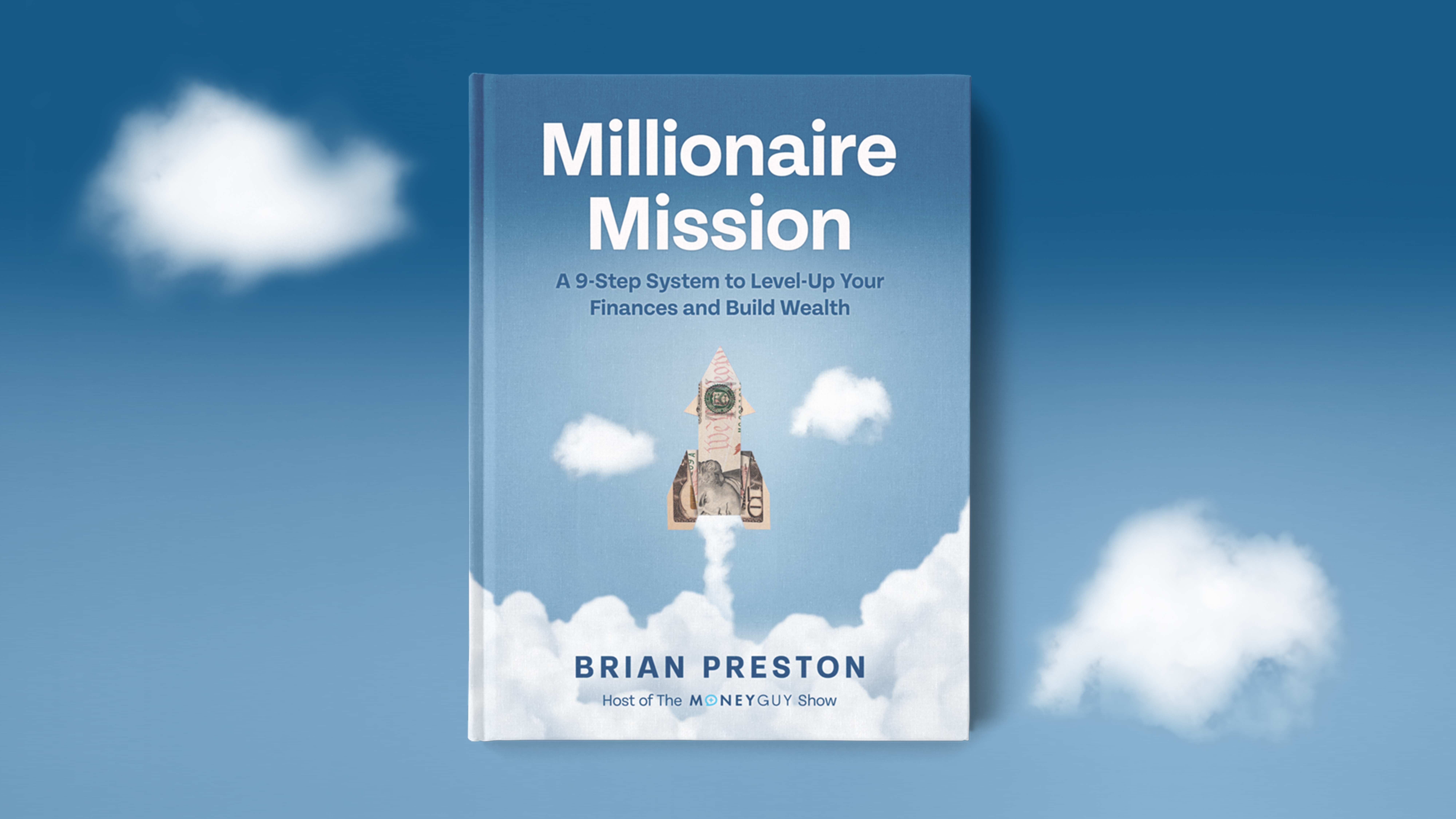
Change your life by
managing your money better.
Subscribe to our free weekly newsletter by entering your email address below.

Subscribe to our free weekly newsletter by entering your email address below.
You may have heard of life insurance or annuity products that track the market – maybe you even have a family friend that sells them. In this Q&A, we analyze a real policy and show you the real returns so you can see how it stacks up against investing in the stock market!
Subscribe on these platforms or wherever you listen to podcasts! Turn on notifications to keep up with our new content, including:
Beware! There’s an annuity out there that could destroy your retirement. Brian, I am so excited about this one because this is real life. This is the real world. This is something that has happened out there in the wild. It’s not like a theoretical case study; it’s not like, “Oh, this might exist.” We found one, and we are going to dive into just how bad this can be. So, I’m assuming most parts of the world, except for Hawaii, they’re snakes. They’re snakes all over the place. The majority of them don’t have poison in them. Like, you go out hiking with the family, you see a big snake, but then you always hear in the books about the rattlesnake, uh-huh, or the water moccasin, the Mamba. You know, you hear about all these scary things, the Cobra. How many can we name? You’re doing pretty good. I feel like we are the tour guide where I’m actually going to bring out the basket, and I’m going to bravely reach in with my metal thing, and I’m going to pull up the most dangerous thing in the world, and you’re like, “Oh my goodness, these guys are actually going to show us one that they found in the wild and bring it full circle so we can learn the dangers of an annuity.” Because that’s what we’re going to be talking about today: Equity index annuities. And just if you’re not familiar, here’s how these things are pitched. And then I’m going to still leave space for you to give the definition. But the way this is all pitched is that when markets are volatile, these things get sold in mass because while the market’s going up, they use the ratchet analogy. It’s like click, click, click. It’s going up. But then when the market goes down, these don’t go down because they locked in at the higher price. So you’re like, “Wow, this is great. I’m going to get the market’s performance without the risk, all the stuff I hate about investing and taking risk.” That sounds great.
So, what you’re describing, which is obviously describing our Equity Indexed Annuities, an annuity that is tied to some other product. That’s the actual definition. An indexed annuity is a type of annuity contract that pays an interest rate based on the performance of a specified market index, often like the S&P 500. It does exactly what you’re saying, Brian. When the market goes up, you make money. When the market goes down, you don’t lose money. So, a lot of people get excited about that. And so excited about that. These things have been sold for a long time. Brian, this was some of even when you first started the podcast back in 2006. This was some of the very early content that you covered, right?
There, early on in the day. Yeah. I never know what the content team is going to take and doesn’t take from the old man on the porch who gives them stuff. Because I had, I think it was a Jonathan Clements Wall Street Journal personal finance article that I kept in my trusty drawer, and I whipped it out. I was like, “Here’s this fine article on these things that I’ve been talking about since 2006.” But it didn’t make the cut. But yes, I have been railing on these products because they appeal to all of your emotions and all of your fears. Remember, more money has been lost trying to time the market or fearing what’s going on with the market than has actually been lost in the market. And we’re going to show you why. There are entire industries that are going to prey upon your fears and maximize their profits to your detriment. You need to be aware of this.
So we actually have a friend of the show who says, “Hey, I’ve got this annuity. I’d love for you guys to take a look at it. I’m not sure what happened last year. Will you guys help me uncover this? Help me dive into it to see what happened?” We said we looked at it, and the statement was interesting. So then we said, “Hey, can you send us some of the back statements?” That’s what we’re basing this off of today. But before we dive into that specific case study, let’s talk about the brochure. Let’s talk about how these things are marketed. You’ve already mentioned this. They tell you, “Hey, if you’re going to do this, you get market returns without the risk of losing money. There’s all up, no down. It sounds amazing.”
Now, there are also guaranteed interest rate options available in these sorts of things. So maybe you don’t like investing, maybe you don’t want the market risk, maybe you don’t think the market’s going to go up. That’s okay. Fixed interest options available inside of these things. So, even for the most conservative investors, there’s a solution. And then, when the salesman’s talking to you, they’ll tell you something like this, “Hey, just so you know, with this product that I’m selling you right now today, there’s some free money on the table. If you sign up for this product today, we might give you a bonus of X percent over X number of years, or we might amp up your return for some specified period of time.” So you hear these things, and you’re like, “Holy cow, this thing sounds amazing. It sounds almost too good to be true.” That’s the brochure, Brian. Now, let’s talk about some of the traps. What are some of the things that people need to be worried about when it comes to these types of products?
The first thing, participation rates, because they are very quick to let you know, well, not quick, but it’s in there if you read the fine details, is that when markets go up, you don’t get it all. You only get a portion of it. That’s the participation rate. Surrender charges. What they say is, “Hey, when you buy this product, if you don’t like it, you don’t get to vote with your feet and leave. We’re going to make sure that when you buy this product, you have to commit that you’re going to own it for 10, 12, sometimes even 15 years. And if you want to get out of it, if you want to surrender it, we’re going to charge you a penalty to do so.” By doing that, they can control your behavior and control your ability to leave.
I think this one was a 12-year surrender period, and what I was surprised when I was looking at the actual breakpoints on it is it stayed high double digits surrender charge really until right until the end. Then it dropped from 10 to six and then to zero, which was much higher than I would have anticipated.
Another thing that these annuities can do is they can also offer teaser rates. So, they might say something like, “We’re going to give you some sort of S&P 500 performance, and it’s going to be a high number, 9% annually or 3% monthly or whatever that may be.” But after the first year, it’s going to fall off, it’s going to drop back down. So what you think is going to happen over the life of the policy may, in reality, only be available to you for the first year, two years, three years, and then it goes away.
Now, this product was originally sold in 2006. I would have loved to have gotten the feedback from the individual who shared this with us, is that how much was the performance that was highlighted in the sales call based upon this teaser period versus how much this was over the long term? Here’s what I think is interesting about these products. They’re really good in the beginning, typically because they’re juiced with these teaser rates. I think that a lot of this is in the design that they want you by the end of the surrender period to essentially buy another policy to once again juice the performance with the teasers. So they create this cycle to keep this process going. But be very aware, those teaser rates are where the good stuff is, and the longer you own this, like, unlike most things with investing, the longer you hold it, the more you’re rewarded. These things actually start to spoil like fish. The longer you hold it.
And the last thing, and we’re going to talk about this a little bit, is that most of these products have some sort of monthly or yearly cap. So when you actually look at the investment options, they might tell you that, yeah, you can invest in the S&P 500. But they’re going to look at it on a year-to-year point system, they’re going to look at it on a month-to-month point system to calculate what rate of return you as the investor get. Well, in most scenarios when we invest, we don’t think of things in terms of month-to-month. That’s how the return works. So we wanted to walk you through a very elementary example of how a month-to-month point system works.
So, let’s assume that you have monthly returns on the S&P 500 for January through December of 3% every single month. But in April, you know, it’s tax time, everybody doesn’t like that. The market falls. It drops 10%. Well, let’s assume that the annuity product you bought says, “Hey, we’re going to cap your return at 1%, but we’re going to make sure this annuity product never loses value. It’s not going to go down. It’s not going to go to zero.” That is misleading because what ends up happening is they’re calculating your monthly return, they calculate the total return that you receive. It accumulates through time. So, month one, you got 1%, then month two, it goes to 2%. Month three, 3%. But then in that 10% drawdown, rather than have you getting credit for zero, it actually decreases that cumulative return by 10%. So now, you’re at 7%. And then you get the 1% month and the 1% month and the 1% month so that when you look through this specific example, if the S&P were to make 25% in this 12-month period, the total interest paid based on the way the annuity companies calculate this, this month-to-month total, would have only been 1%. This is the diabolic part of this whole thing. It’s the design. I think it’s interesting that you’re going to cap the upside at a paltry 1%. But then you’re going to let the downside be ungoverned. It’s just going to be wide open. So you get all of the down, but you’re limited up. And here’s why, because we’re about to show you the big unveiling. What makes this horrible to me, you guys know, because we talk to you about what we call the pluck effect, and we use the analogy of a rubber band. This is how we tell you to stay the course when markets are volatile, when they’re scary.
The further the market drops in the short term, the more velocity and momentum is building behind the scenes. You know what happens when you let go of the rubber band? Boom! It pops. I mean, you get… Typically, that’s why we hear talk about V-shaped recoveries. It’s not uncommon that the worst performing month will be followed by a very strong performing month. Because that’s where the recoveries occur. So, if you have a product designed where it gets all the downside, you’re pulling the rubber band through the pluck effect. But then, you unfortunately, on the recovery, never get it because they voided out the next month and kept it at 1%. Diabolic. I mean, this is evil genius. Surprisingly, it’s not in a superhero movie where Captain America has to crash through this thing or Iron Man and Tony Stark.
Because this is just ridiculous. Because look at these real numbers. So yeah, this is a theoretical example the content team put together. We want to show you what we actually pulled off of the statement that this friend of the show sent to us. This is their actual statement details from June 15th, 2022, to June 15th, 2023. And in column one, you can see the S&P 500 returns: 1.9%, 11.2%, negative 99.2%, negative 5.7%. Because we know 2022 was a volatile year. There were ups and downs in the market. Well, the way that this annuity company calculates that month-to-month return is they got the 1% cap on the up months, but on the down months, they still got credited the full amount of the downturn. So, when you run through the annual accumulation throughout the course of this year, according to their calculation, they should have been credited negative 16.9%. But remember, it’s an equity index annuity. You can’t lose money. You get credit for zero, so your account doesn’t lose money. It stays flat.
What’s so frustrating is that if you have actually looked at how the S&P 500 performed over this time period, it made 16.8%. Even though it was a yo-yo string going up and down, it still made almost 17%. This particular person, in this particular annuity, got credited at 0% for the year. It’s those big recovery months, because like I said, you’re getting all the downs. So, you look at August of 2022, the market lost 9% that month. So, they got the full 9% out of the cumulative performance for that one-year look period. But here’s what it doesn’t show you. In July, the month before, the market had made 11.2% in one month. They got credited for 1%, so they gutted 10.2% of the performance.
And then you look at the recovery that occurred after the down periods of August and September. In October, the market once again made 8.1%. I mean, this is a big recovery. They got credited for 1%. So, you see, this thing never recovers from the downside because it’s down 12%, even after the 8 and 12% recovery. Diabolic and evil genius design just keeps coming to mind, because how do you lose in this? And that’s the part, and here’s the thing, we didn’t even pick on. It doesn’t include dividends, which we know on an ongoing basis, dividends being reinvested is definitely very valuable to your long-term performance. This is something that appeals to your emotions. But if you look at the analytics and actually understand the analytics of this, you realize it was never designed to be successful. And that’s the part when you actually now look at the actual cumulative effect, because realize this contract went into effect in 2006.
Now, look, I think if you look back in history, 2006 was after a huge run-up. You know, from the dot-com bubble, we’ve had a good bit of recovery. But we’re right before we’re going to hit the Great Recession. So you would think this is a good time to probably buy an equity index annuity, right? Right before the Great Recession. I love that about our live chat while we’re recording. Someone just said, “Hey, I bet if they bought the annuity in 2006, probably did okay.” Well, let’s look at it, right? So they made a $50,000 contribution into this annuity, and they got a bonus. There was a 1% guaranteed additional bonus interest rate for the first 12 years. So 1% additional baked in, and the month-to-month cap rate that they were going to get to experience was 3.1%. But that’s not the whole story. After the first year, it dropped to a 1% cap rate. And I didn’t draw enough attention when we went through the numbers, because you know how this is probably pitched in the discussion since we as humans think in a linear standpoint, we don’t think exponentially like markets typically.
Because you saw that true performance is packaged in 11% months, losing 3% months, making 8%, another month. It stacks in at all kinds of different shapes and sizes. But in our linear minds, when somebody says you can make 1% a month, we’re thinking, “Oh, we can make 12% a year.” That’s what we do. It doesn’t work that way. And in that year where they showed you in the first teaser year, you can make 3% a month, you’re thinking, “There’s 12 months in a year. I could make 36%. Do we have another 1996 or 2013 year? Crush it with this type of thing.” But that is not the way performance comes. It comes much more concentrated both in the up and the downside. And that is where the design is going to smoke your behavior, is going to take advantage of your behavior and your emotional limitations. And the design is going to keep it all for the insurance company.
Now, let’s look at the rest of the story when we look at this annuity product. He bought it for $50,000 in 2006. And then, as of today or as of 2023, it’s worth $1,365. Had he taken that same $50,000 in 2006 and just bought the S&P 500, just bought the index, not added any more money to it and just let it be invested with dividends being reinvested, that $50,000 would have turned into almost $250,000. That is an annualized rate of return of 4% on the annuity versus almost 10% in the S&P 500. So the question we have is, is the annuity product worth it? Did he know what he was actually buying? And is the security that he received from it worth the dollars that he gave up to have?
And I do want to remind everyone when you see the… Because you look at the… “Oh, it’s at 4.18%.” You know that cash was underperforming during this period, like, well, that seems very reasonable. But realize it is very much leaning into those teaser rates and the bonuses and the free money that was given in on the front end of this product design that if we didn’t have that, it would have gotten at least 1% out of the performance. So that’s something to know, especially with all the, “You don’t lose money” conversations.
I think it’s important to understand that it’s easy to fall into the emotional trap of annuities like this one, especially when they promise guarantees and safety. However, as we’ve shown in this case, and as we’ve seen in many others, these products often fall far short of their promises. They have complex structures, they impose significant fees, and they can significantly limit your potential for growth. It’s essential to carefully consider the trade-offs between safety and potential return and understand the fine print and terms of these annuities before purchasing them.
Don’t fall for the fear-based selling tactics. Don’t be lured by the idea of guarantees if those guarantees come at the expense of substantial growth potential. Instead, focus on building a well-diversified investment portfolio that aligns with your financial goals, risk tolerance, and time horizon. If you’re concerned about market volatility, there are more transparent and cost-effective ways to manage risk without locking yourself into a complex and potentially unfavorable annuity product.
Brian, we are always on a mission to educate and empower our audience. And one of the best ways to do that is to share real-world examples like this one, where we can dissect and analyze these financial products and demonstrate their pros and cons. So thank you for diving into this Equity Indexed Annuity case study with me. It’s a valuable lesson for our audience, and I hope it helps them make more informed financial decisions. For more information, check out our free resources.


How Much Should You Save?
How much of your income can you replace in retirement? You can replace different portions of your income in retirement…
View Resource
Are You a Prodigious Accumulator of Wealth?
Is your net worth on-track for retirement? A Prodigious Accumulator of Wealth (PAW) has twice or more than the expected…
View Resource


How about more sense and more money?
Check for blindspots and shift into the financial fast-lane. Join a community of like minded Financial Mutants as we accelerate our wealth building process and have fun while doing it.




It's like finding some change in the couch cushions.
Watch or listen every week to learn and apply financial strategies to grow your wealth and live your best life.
Subscribe to our free weekly newsletter by entering your email address below.